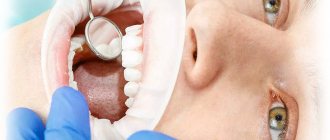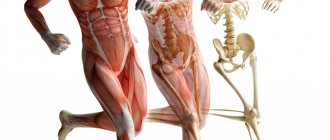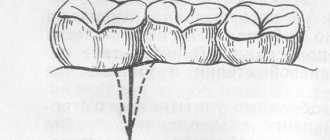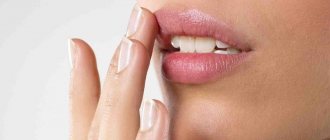Why do ulcers appear on the gums, and is it always dangerous?
There are many possible reasons. To understand how dangerous the appearance of certain lesions on the gums is, you need to look at additional accompanying symptoms:
- in case it is trivial mechanical damage. The gums can be damaged by hard food, a toothbrush, or a foreign object. These lesions may resolve in 3-5 days. If a person does not brush his teeth, then infection is added to these damages, and healing may take several weeks.
- Sometimes ulcers can appear as a result of wearing orthodontic structures, braces or removable dentures.
Scratch on the gum and possible complications
Infection of even a small scratch leads to swelling of the gums and the appearance of small bumps, causing discomfort when chewing. The tissue around the wound becomes inflamed, acquires a reddish tint and increases in volume.
Consultation with a doctor is required for the following symptoms of exacerbation:
- the appearance of swelling and a change in the color of the scratch to whitish;
- leakage of ichor or cloudy liquid;
- tugging or throbbing pain that spreads to other parts of the oral cavity.
These signs indicate that a purulent inflammatory process has begun. The infection can spread to the roots of the teeth, disrupting blood circulation, causing acute gingivitis, pulpitis or other complications.
In addition, inflammation is accompanied by constant pain, which interferes with eating, sleeping and disrupting normal functioning. The wound reacts especially acutely to the ingress of pepper, salt, and spices. All this can lead to the development of stomatitis and rashes.
That is why any scratch cannot be left unattended. It is necessary to immediately inspect the damaged area and treat it.
The most common diseases of the oral cavity in which ulcers appear
- ulcerative necrotizing gingivitis. The cause of this disease is bacteria that multiply when immunity decreases. Extensive ulcers appear on the gums, regional lymph nodes become enlarged, and the temperature may rise
- chronic recurrent aphthous stomatitis. Up to 4-5 white spots first appear in the mouth, which later turn into ulcers. There is no temperature or other problems related to well-being. If such symptoms appear 1-2 times a year in small quantities, then there should be no cause for concern. Frequent occurrence is associated with weakened immunity and possible intestinal diseases, as well as allergies.
- acute herpetic stomatitis. Herpetic stomatitis occurs in a child when he first encounters the herpes virus. Many bubbles appear on the gums, which, after bursting, turn into ulcers that merge with each other. The gums are always bright red, and the ulcers themselves are very painful, the temperature may rise
How can you get rid of sores in your mouth?
How to treat wounds in the mouth if they appear and cause discomfort. Initially, you need to determine the true causes of their occurrence. This will help not only choose the right treatment, but also reduce the risk of relapse. If simply stomatitis has formed, it is not difficult to recognize it, but a purulent wound in the mouth of unknown pathogenesis is a reason to consult a doctor. Particular attention should be paid to lesions that do not heal for more than 10 days.
For a quick recovery, use:
- medicinal ointments with anti-inflammatory effect;
- antibiotics if the cause is a bacterial infection;
- complex of vitamins;
- rinsing with oral antiseptics;
- protective applications;
- painkiller injections;
- laser cauterization.
First aid
If the temperature rises, you can take an antipyretic drug. In the future, before visiting a doctor, nothing should be done. Do not take antibiotics yourself or try to get into the ulcer with any object.
How to relieve symptoms of ulcers
- do not eat sour and salty foods
- food should be warm, no hot dishes or drinks
- Care should be taken to ensure that the child does not put dirty hands in his mouth
- teeth should be brushed, but make sure that the bristles do not touch the gums with ulcers
- It is recommended to rinse your mouth with herbal solutions (oak bark, chamomile) 3-4 times a day
You should be careful when using antibacterial solutions. They must be prescribed by a doctor. If such solutions are used incorrectly, they can provoke the development of thrush. The antibacterial agent will “kill” the beneficial microflora, which can result in a fungal infection.
Prevention of ulcers
- professional oral hygiene at least 2 times a year
- Regularly replacing your toothbrush
- Proper brushing of teeth at least 2 times a day
- using additional hygiene techniques such as irrigators, dental floss, and tongue scrapers
- Children should be monitored for bad habits such as putting dirty fingers and other objects into their mouths
- It is important to treat your teeth in a timely manner. Microbes that are found in carious teeth and rotten roots can serve as a source of infection for ulcers
If you have problems in the oral cavity, contact the specialists of the Center for Family Dentistry!
Procedure
A dentist discusses gum transplant surgery with a patient.
There are different types of gum grafts available.
There are a variety of gum grafts, and the type of surgery depends on the extent and severity of the damage and the individual's individual needs.
The periodontist will discuss the different types of surgery available with the person to decide which option is most suitable.
Before the gum graft begins, the periodontist will administer a local anesthetic to numb the area so that the procedure is not affected.
They may also remove some of the existing gum to expose the root of the tooth and clean it.
Three different types of gum transplant surgery:
In this procedure, the periodontist:
- removes tissue from the roof of the mouth by making a flap and taking tissue from underneath the top layer
- sews tissue onto existing gum tissue to cover the exposed tooth
- seams flap on the roof of the mouth where they got the fabric from
Free gum vaccinations
This is the preferred method for people with thin gums who require additional tissue to enlarge their gums.
In this procedure, the periodontist:
- removes tissue directly from the top layer of tissue on the roof of the mouth
- stitches this tissue down to the existing gum area
Pedicle (lateral) grafts
This is the preferred method for people who have a lot of gum tissue growing near an exposed tooth.
In this procedure, the periodontist:
- gum graft tissue around or adjacent to the tooth in need of treatment
- only partially cuts off this tissue, supporting one edge
- stretches the tissue over or down to cover the exposed tooth root and hold it in place with stitches
The periodontist can remove tissue from a tissue bank rather than removing rubbery tissue from a person's mouth.
Preparing for gum transplant surgery
Someone must drive the person home after the procedure.
Once you and your dentist have considered all the options and decided on the type of surgery, it is important to ensure that a family member or friend accompanies you.
This is important because pain medications are not safe during gum graft surgery.
People who receive gum vaccinations will be able to return home after the procedure. The doctor will provide all post-operative care instructions to ensure successful healing of the graft.
Recovery
Recovery will help:
- avoid brushing teeth at the treatment site
- use a special mouthwash to reduce plaque buildup
- take antibiotics to reduce the risk of infection
- avoid strenuous exercise
- avoid foods that are difficult to eat
- eating soft, cool foods such as ice cream, pasta, eggs, yogurt, and soft cheese
- avoid smoking
The pain and discomfort a person experiences will vary. For example, if the periodontist uses tissue from a tissue bank, the person will experience minimal pain. If tissue from the roof of the mouth is removed, a person may feel pain for several days.
The healing process is often quick, with 1 to 2 weeks for the mouth to completely heal, but can sometimes take longer. People can take over-the-counter pain relievers or prescription medications to help manage any discomfort.
After the procedure, teeth may become more sensitive than usual, especially to hot and cold foods, and people may benefit from using a desensitizing toothpaste or mouthwash.
Most can return to work the next day.
There will likely be a follow-up appointment with your dentist after surgery to check that the healing process is going well as expected. The dentist may also remove sutures if necessary.
Not only will your gums look different after surgery, but they may become stiffer and harder.
Why do gums hurt under dentures?
Among the main reasons influencing the development of gum pain after prosthetics are:
- Incorrectly installed prosthesis. Errors in choosing the size and shape of the structure cause discomfort. Crowns press and rub the gums. The situation is aggravated by the fact that with frequent consumption of solid foods, toffees and other foods, the position of the structure changes, which causes chafing and wounds on the mucous membrane.
- Allergic reaction. Intoxication occurs if the patient has a tendency to be allergic to cobalt, copper, chromium, nickel and metal alloys. It is also enhanced when installing metal ceramics.
- The case is dangerous. If assistance is not provided in a timely manner, there is a risk of developing Quincke's edema.
- Diseases of the gums, mouth and teeth. If a foreign object is installed during an infection of the oral cavity, the disease can develop into gingivitis, fungal stomatitis, cyst, candidiasis, caries. Symptoms may vary. For example, soft plaque accumulates under the denture; when you press the plate, the pain intensifies, the gums bleed and swell. Periodontal tissues are deeply affected, and ulcers appear on the alveolar processes.
Are there any complications?
Complications from gum graft surgery are minimal and uncommon.
However, it is possible that people may experience the following:
- bleeding gums
- swollen gums
- the teeth seem to wobble (although this should only be temporary)
- too sensitive teeth
- gaps between teeth
- infection
Sometimes the graft tissue may not attach properly to the graft site. This is very rare, but if it occurs, further surgery may be required.
Some people don't like the way their smile looks after surgery. In these situations, the periodontist can reshape the gums to help change the way they look.
Preventive measures
To prevent a negative reaction after the installation of dentures, you should follow the strict instructions and recommendations of the dentist. It is necessary to maintain oral hygiene to reduce the risk of inflammation.
To do this, the specialist recommends adhering to the following prevention methods:
- Removable structures must be removed at night. Thus, the gums “rest.” This clause does not apply during the first week of installation.
- You should periodically massage your gums. Using your finger will speed up blood flow and relieve tension from soft tissues.
- When brushing your teeth daily to remove plaque, you need to pay attention to the interdental space and tongue. It is necessary to clean out food debris in the cracks, otherwise an inflammatory process will develop over time. A brush with fine soft bristles and a irrigator should be used to prevent stones. Cleaning time is at least 2 minutes.
- When eating food, you need to distribute the load evenly on both sides of the jaw.
- Rinse after every meal. Herbal infusions and purified water can be used.
- Avoid foods such as chewing gum, nuts, crackers, gummy candies, and hard fruits.
- If indicated, complete absence of dentition, bone tissue atrophy or anatomical features of the jaw, use fixing gels, creams, powders.
Following these dental care rules will allow your gums to quickly adapt to the structure. If cracks, breaks, or loose fit of the plates to the gums appear, you should contact a professional.









